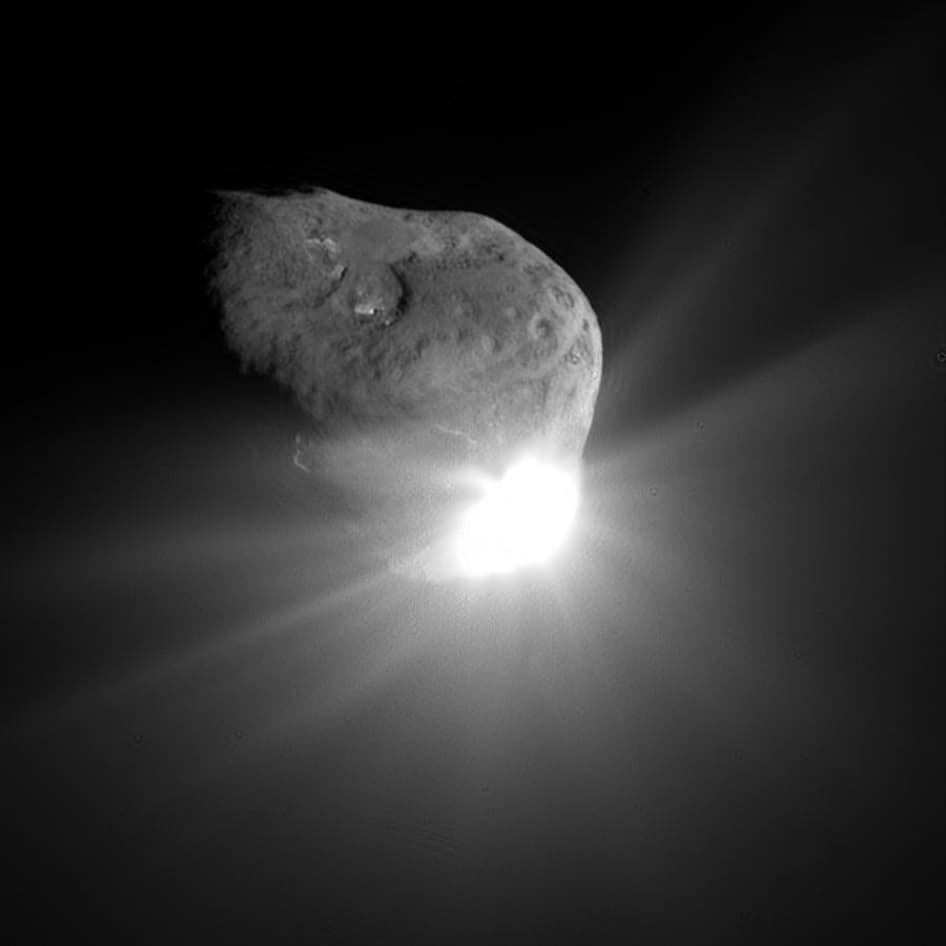$32.5M NASA & UMD Funding Agreement Supports Study of Comets, Asteroids and Meteorites
UMD Astronomers to Expand and Upgrade Database of Small Space Objects
Kimbra Cutlip , 301-405-9463 kcutlip@umd.edu
NASA has committed $32.5 million to extend an cooperative agreement with the University of Maryland that allows UMD to continue overseeing the space agency’s data on asteroids, comets, meteorites and other small objects in space—an area of study where UMD research has made major contributions.
Under the agreement, which runs through 2026, the UMD-managed Small Bodies Node (SBN) of NASA’s Planetary Data System will be able to improve and expand its services including providing increased public access. The funds will also support the Minor Planet Center, an SBN subnode jointly operated by Harvard and the Smithsonian Institution. The Minor Planet Center serves as the international clearinghouse for reported positional data on all comets and asteroids, classifies the orbits of newly discovered objects and supports efforts to follow up on near-Earth objects by astronomers.
The Planetary Data System program ensures that data collected on NASA missions is cataloged, archived and made publicly accessible for future studies.
“Every time NASA runs a mission to explore something in space, there is all this data collected—whether it’s spectral data, radar data, telescope data, photographs—and our goal is to make sure that data is not lost and is useful to future generations,” said James Bauer, a research professor in UMD’s Department of Astronomy and principal investigator for the Small Bodies Node.
The cooperative agreement was initially forged in 2015, but the SBN itself was established at UMD in 1995 by the late UMD astronomer Michael A’Hearn, who led the Deep Impact Mission, which successfully collided with comet Tempel 1 to reveal its sub-surface composition. Since its establishment, the node has archived data from the New Horizons mission to Pluto and the Kuiper belt, the European Space Agency’s Rosetta mission and other missions. More than 101 peer-reviewed journal articles have referenced Small Bodies Node datasets.
"The Small Bodies Node is an exceptional example of the University of Maryland's commitment to strengthening research and education through federal partnerships," said Amitabh Varshney, UMD's interim vice president for research and dean of the College of Computer, Mathematical, and Natural Sciences. "The Small Bodies Node plays an important role in discovery and advancing our knowledge of the universe."
“We look forward to our ongoing relationship with the Small Bodies Node,” said Timothy McClanahan, the Planetary Data System project office manager for NASA. “Small Bodies Node has proven itself to be a great partner to NASA, the Planetary Data System and the greater planetary community.”
In addition to housing NASA mission data, the SBN maintains the online archiving facility, a web application that allows individuals to submit data to be archived and made available to the public. The SBN also provides multiple tools for public access to all of the data it houses.
SBN search tools include the Data Ferret, which contains physical and orbital data on every small body in the archive, and the Small Bodies Image Browser, which provides a map-based search for images from missions to small bodies. Another search tool, designed by UMD astronomers, is called CATCH (for Comet/Asteroid Telescopic Catalog Hub) and allows users to search through ground-based, all-sky surveys for images containing specific comets and asteroids, including publicly available images from outside the Planetary Data System. On average, users download more than 10,000 images per month from SBN.
Renewal of the agreement will allow the Small Bodies Node to upgrade its platform and expand its services. Planned upgrades include:
Improving user access to the Minor Planet Center’s main database,
Incorporating NASA-funded telescope surveys of the whole sky,
Updating the archive to NASA’s new data standard,
Moving the archive to the cloud and moving the node website from a UMD-administered site to a NASA-managed web service, and
Creating products to allow the archive’s data to be accessed by other archives and libraries.
With the expanded services, Bauer said the node expects to scale up its holdings from around 100 terabytes of data to thousands of terabytes and plans to develop specialized tools to make data searches quicker and more efficient. The team also plans to increase accessibility of the data among users with different computer systems and across a variety of application program interfaces.
“As more analytical tools become available, we can continue to learn from the data, but it needs to be categorized and identified in a standardized way so that people can recognize and use the data several years or even decades later,” Bauer said.
The $32.5 million cooperative agreement includes funds to enhance Minor Planet Center activities as well as a subcontract administered by Bowie State University to enhance the discovery of SBN data use by the public. The agreement will also enhance activities by the International Asteroid Warning Network through a subcontract to NEO Sciences, LLC.
Follow @UMDRightNow on Twitter for news, UMD experts and campus updates

